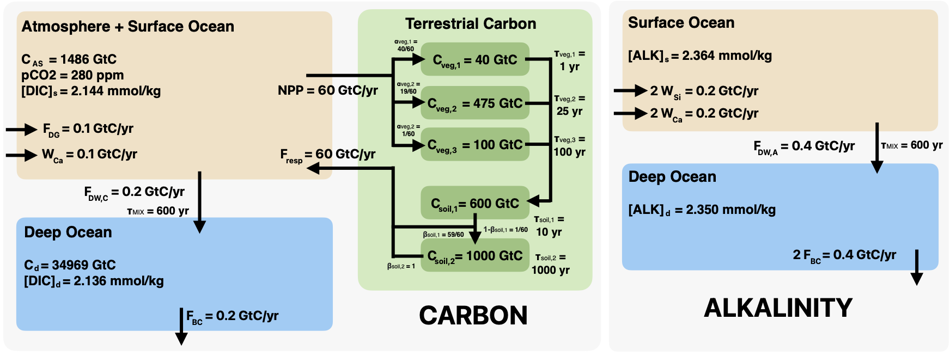Vegetation
Vegetation and soil physics
The Longterm Climate Model is a box model with three types of prognostic boxes: ocean, soil, and vegetation. The Longterm logo depicts these boxes in its default configuration. In every configuration, there are two ocean boxes, colored blue in the logo. In the default configuration, there are three vegetation boxes, shown in green, and two soil boxes, shown in brown.

The Longterm logo depicts two ocean boxes (blue), three vegetation boxes (green), and two soil boxes (brown).
Longterm integrates \(6 + n_\mathrm{veg} + n_\mathrm{soil}\) prognostic variables, where \(n_\mathrm{veg}\) and \(n_\mathrm{soil}\) are the numbers of vegetation and soil boxes, respectively. Therefore, in the default configuration of \(n_\mathrm{veg} = 3\) and \(n_\mathrm{soil} = 2\), there are 11 prognostic variables: two for temperature, two for alkalinity, and seven for carbon. These variables are distributed among boxes as follows:
| Box | Carbon | Temperature | Alkalinity |
|---|---|---|---|
| Surface ocean | x | x | x |
| Deep ocean | x | ||
| Vegetation | x | ||
| Soil | x |
The surface-ocean box is slightly special with regards to carbon. Its carbon variable represents not just the mass of carbon in the surface ocean, but the total mass of carbon in the surface ocean and the atmosphere. The carbon is partitioned between them diagnostically and the temperature of the atmosphere is set to 10 K above the temperature of the surface ocean.
The model physics determines the flows of heat, carbon, and alkalinity through these boxes. The sources and sinks of heat for the surface ocean are: radiative forcing from greenhouse gases (CO\(_2\) only), radiative forcing from planetary albedo (sensitive to vegetation only), radiative forcing from intrinsic feedbacks (e.g., Planck, water vapor, and lapse rate all rolled up into one number), and downwelling (and associated upwelling) of water to (from) the deep ocean.

The flows of heat and preindustrial temperatures of the two ocean boxes.
The flows of alkalinity, expressed below in terms of equivalent mass of carbon, are from weathering of terrestrial silicates and carbonates to the surface ocean, downwelling from the surface ocean to the deep ocean, and burial of carbonates on the ocean floor. The flows of carbon are the most complicated. The surface ocean and atmosphere gain carbon from degassing (e.g., volcanoes) and from the weathering of terrestrial carbonates, and they lose carbon via downwelling to the deep ocean. The surface oceana and atmosphere also lose carbon through the net primary productivity of terrestrial vegetation and gain carbon from respiration in soils. The movement of carbon between vegetation and soil pools is governed by decay timescales and preindustrial stocks that can be set by the user. Finally, the deep ocean loses carbon via burial of carbonates on the ocean floor.

The flows of heat and preindustrial temperatures of the two ocean boxes.
The physics governing the flows of heat, carbon, and alkalinity are described in the pages below.
Vegetation and soil physics
Weathering and burial of carbonates and silicates
Governing equation for sea level